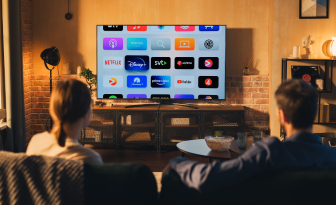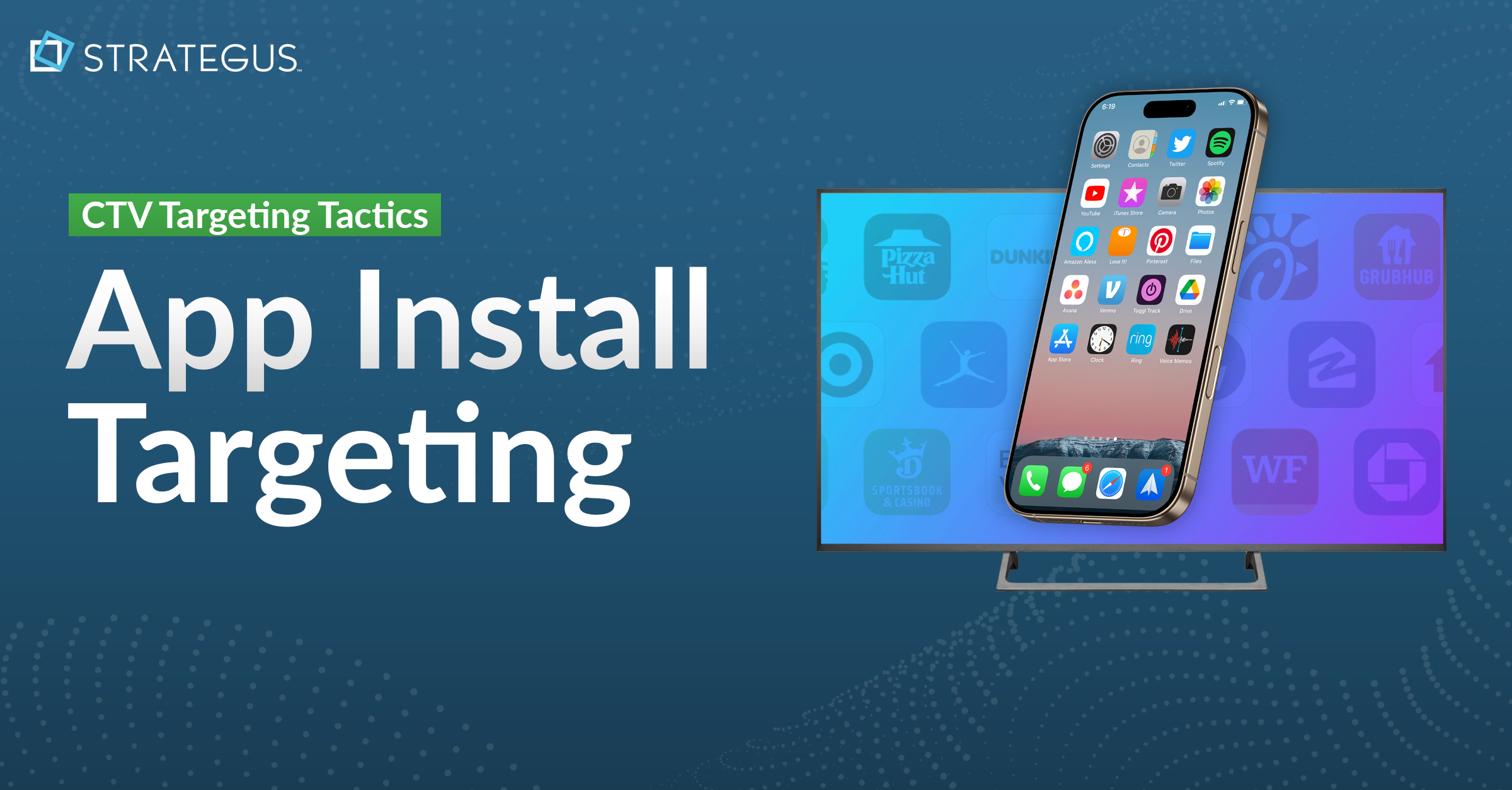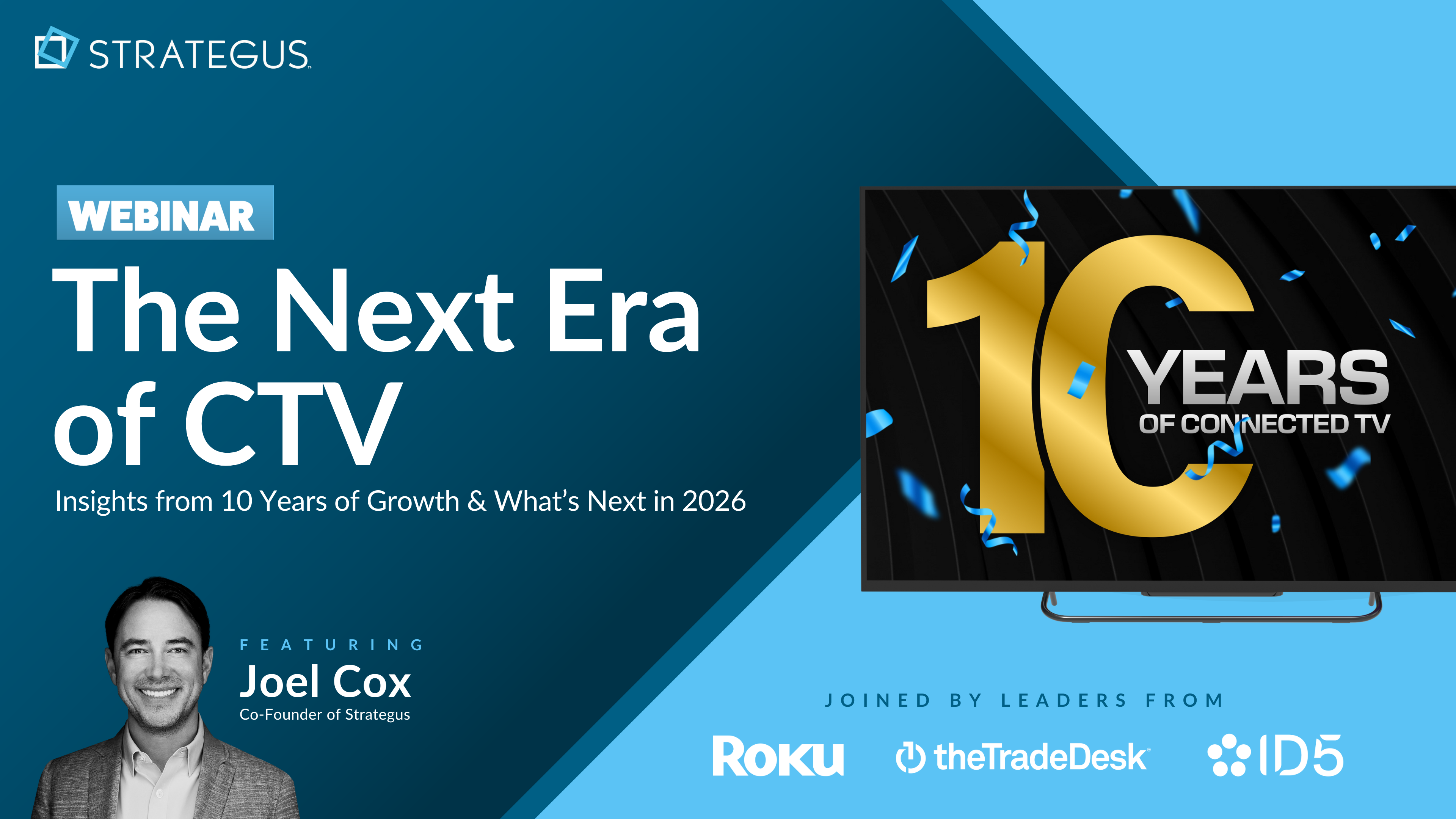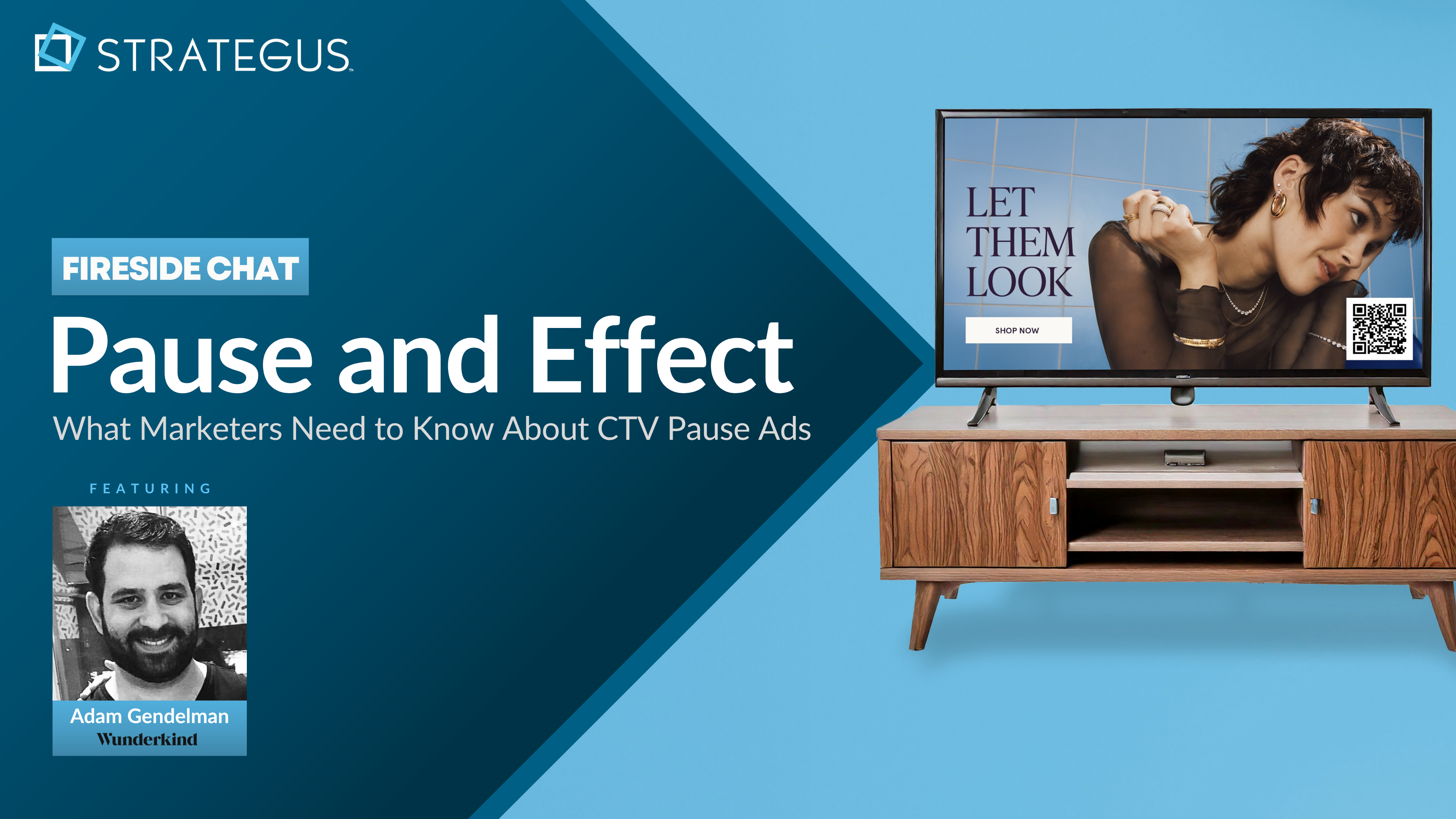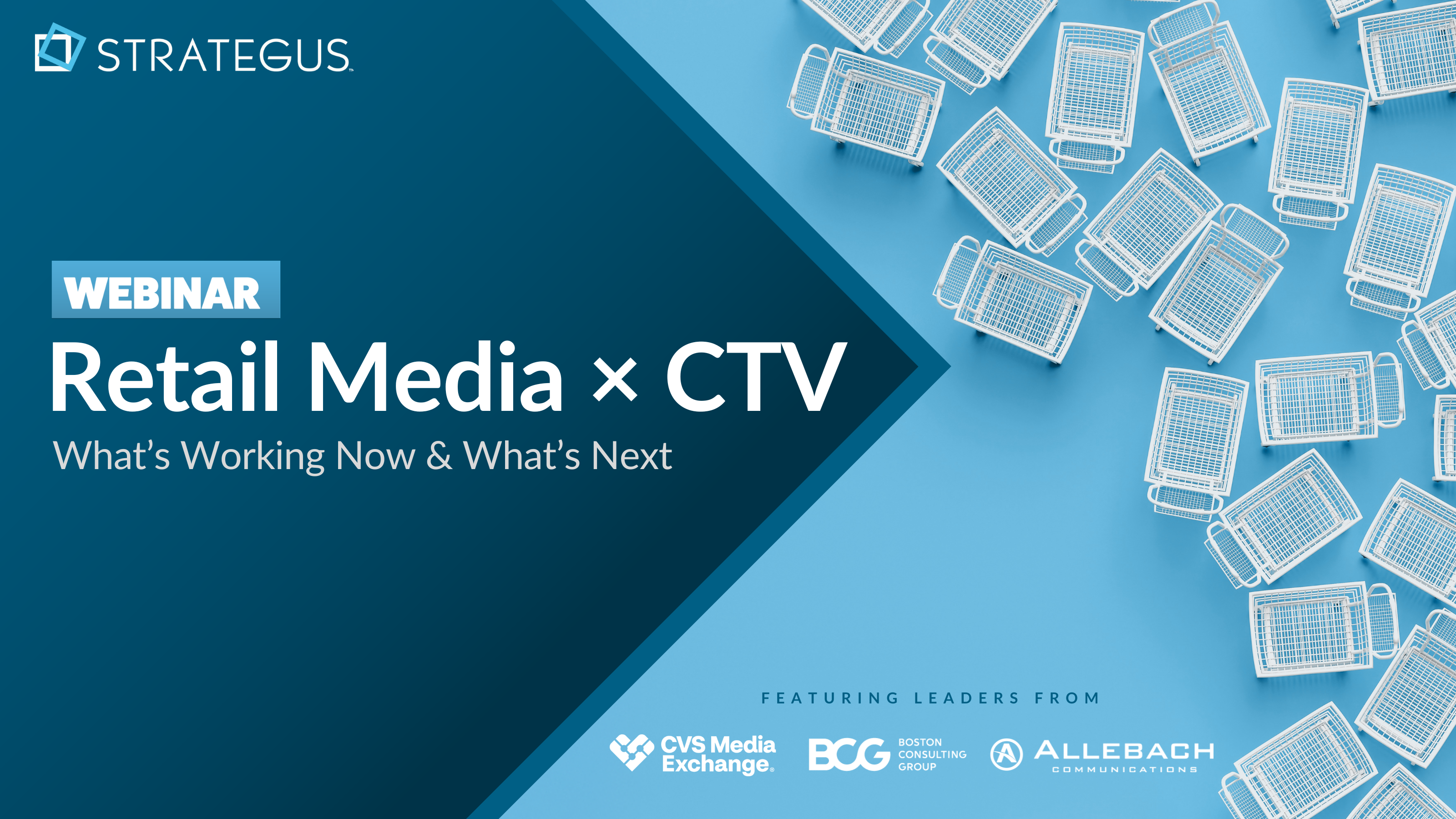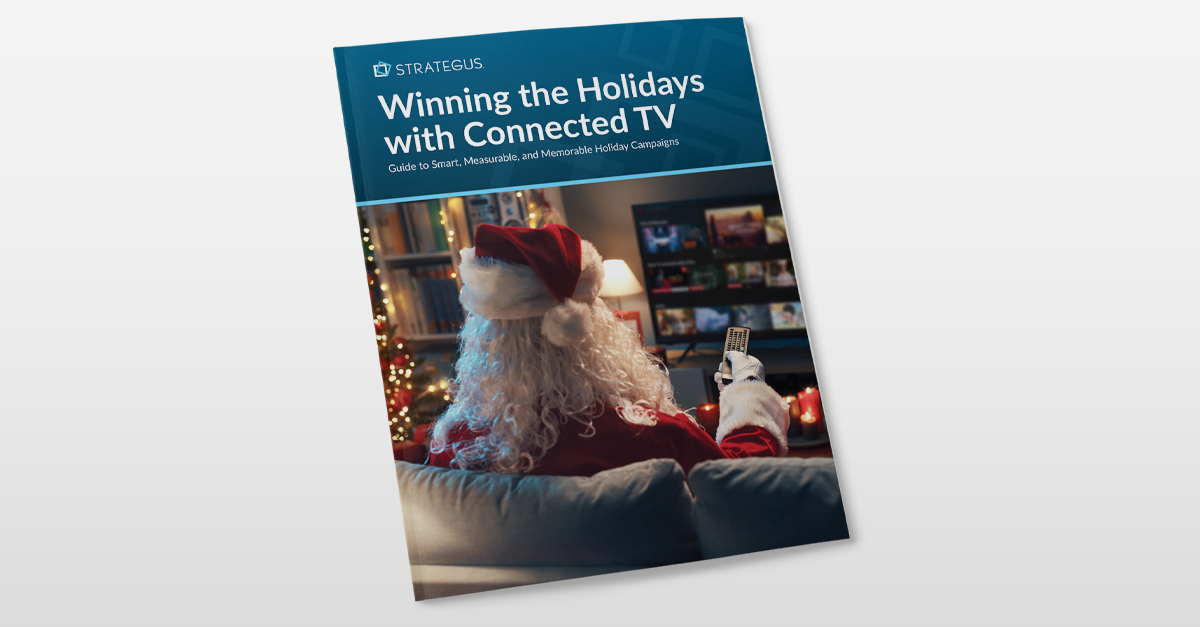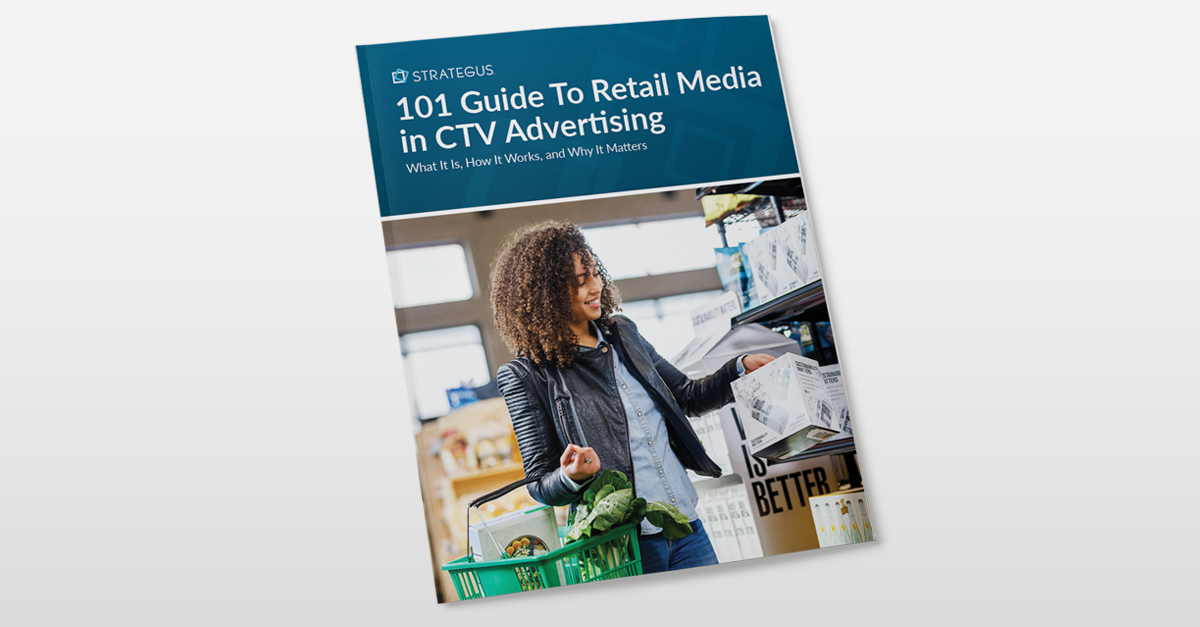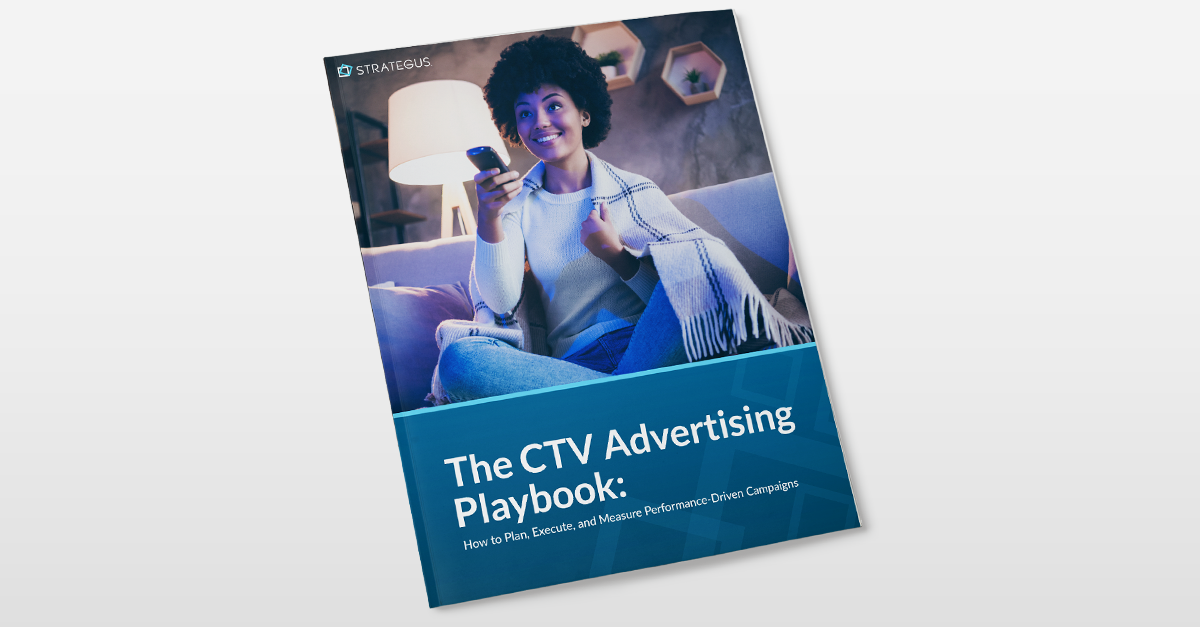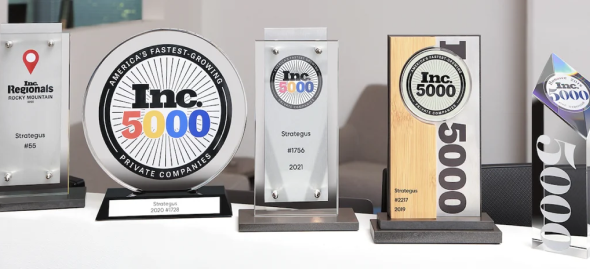- Home
- Strategus Blog
- OTT vs. CTV Advertising: What’s the Difference (With Examples)
OTT vs. CTV Advertising: What’s the Difference (With Examples)
 Traci Ruether
Traci Ruether
13 minutes read
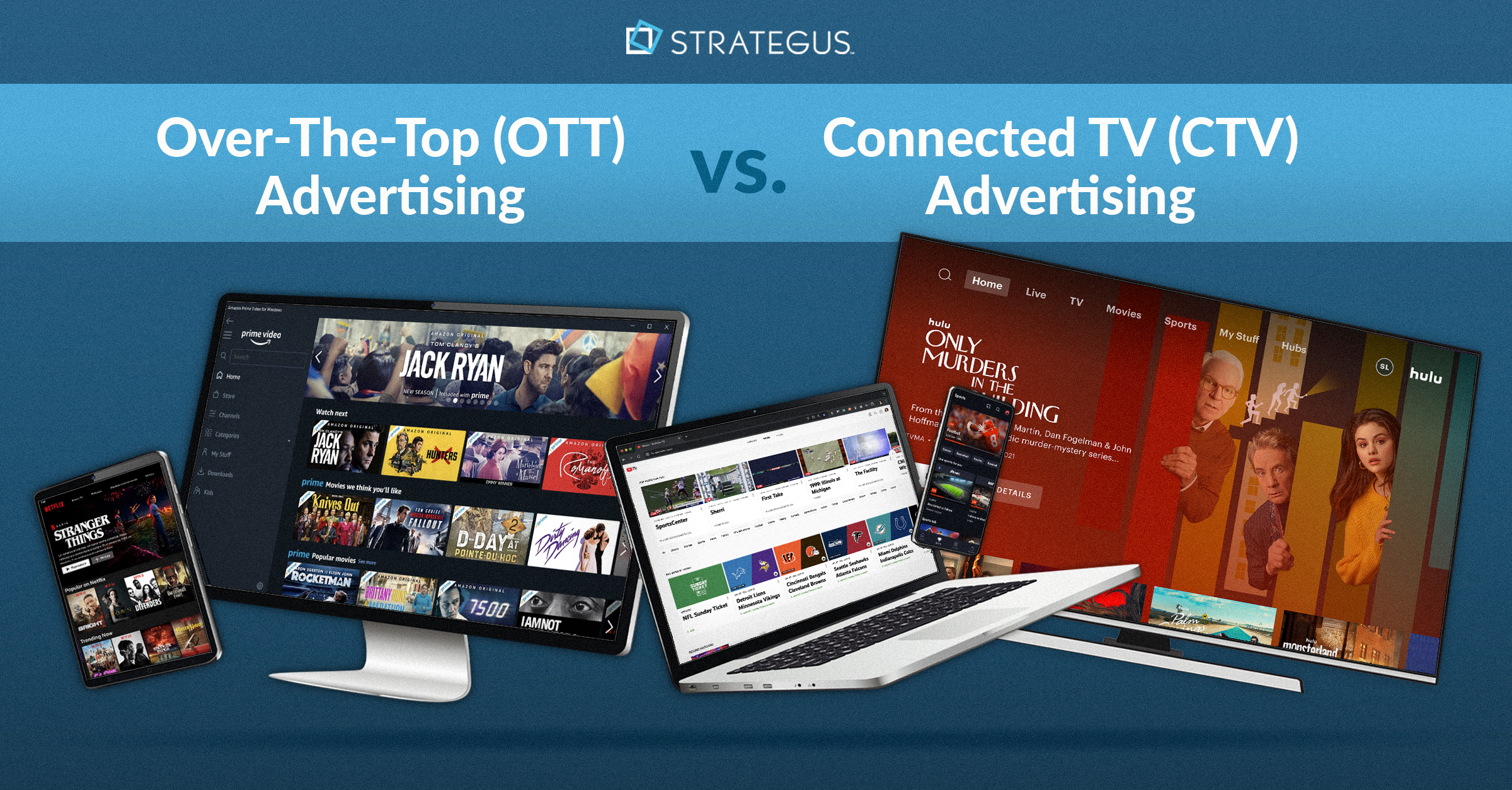
OTT and CTV may seem synonymous, but mixing them up can cost advertisers millions.
In this blog, we’ll look at examples and benefits of CTV and OTT advertising, providing tips on how to combine the two to maximize reach and impact.
What is the Difference Between CTV and OTT?
In simple terms:
- OTT is the delivery method—streaming video content over the internet.
- CTV refers to the device—smart TVs, Roku, Xbox, etc.—used to watch that content on a television screen.
All CTV is OTT, but not all OTT is CTV. In fact, most OTT content is viewed on mobile phones and laptops, not on a living room TV.
That’s important because CTV ads are viewed on large screens, where attention is higher, engagement deeper, and co-viewing more likely. You’re not just buying impressions, you’re buying sight, sound, and scale.
If you’re promised premium CTV inventory, make sure it’s not just mobile OTT dressed up with a higher price tag.
What Is OTT (Over-the-Top)?
OTT describes all streaming media content that’s delivered to viewers using the internet rather than a traditional satellite or cable network.
Top players in the OTT space include Netflix, Disney+, Amazon Prime, Hulu, YouTubeTV, PlutoTV, and Sling. Internet radio and VoIP services like WhatsApp also count as OTT because they bypass traditional broadcasting alternatives — but for this article, we’ll be focusing on video streaming platforms.
How OTT Advertising Works
OTT advertising refers to the video ads that play on OTT services like Amazon Prime. These can take a few different forms:
- Pre-roll video ads that play before a stream starts on someone’s tablet.
- Mid-roll video ads that pop up in the middle of viewing a show on Hulu at home.
- Banner ads that appear as a static graphic overlay during a YouTube video.
- The list goes on.
Because these ads are delivered digitally, they have many advantages over traditional TV advertising. Audience targeting and detailed performance measurement both give OTT advertising a significant edge.
That said, we’ve all flipped to another tab and muted our laptop during a commercial break. And I pushed the ‘skip’ button 5 seconds into a YouTube pre-roll right before starting this article.
This is just one reason why OTT ads delivered to personal devices are not the same as CTV ads that play on the biggest screen in the house.
What Is Connected TV (CTV)?
Connected TV refers to any internet-connected television used to stream video content on streaming services. Some common CTV devices include:
- Smart TVs like the Samsung OLED, which come with an operating system and preloaded apps.
- Streaming devices and set-top boxes like Amazon Fire that transform ‘dumb’ TVs into internet-connected devices that can access streaming content.
- Gaming consoles like the PlayStation that allow users to stream movies, TV shows, and music in addition to playing video games.
How CTV Advertising Works
CTV advertising describes the video ads served to viewers using connected TVs to stream their favorite movies and shows. The benefits of CTV as compared to traditional TV advertising all tie back to data.
Namely, when placing ads in these digital environments, marketers gain access to deep insight about the users they’re targeting and the actions viewers take following exposure.
This allows for much more data-driven tactics, including:
- Precise targeting: Reach specific demographics, interests, and viewing habits.
- Content-agnostic placement: Find your audience, no matter what they’re tuning into, by placing ads programmatically across a vast array of publishers.
- Real-time measurement: Track ad impressions, clicks, and conversions in real time.
- Retargeting: Re-engage viewers who have previously interacted with your brand online.
- Holistic attribution: Gain a comprehensive understanding of how your CTV campaigns contribute to overall marketing goals.
OTT Advertising vs. CTV Advertising
OTT advertising refers to video ads delivered over the internet on any device, while CTV advertising specifically targets ads shown on internet-connected TVs for a big-screen viewing experience.
We’ve established how OTT and CTV advertising allow for more advanced tactics than running ads on your grandma’s cable box.
But what about how the two digital categories compare (OTT and CTV) in terms of ad performance? Does it all just come down to the devices that these ads are viewed on? And, if so, is a video ad on the living room TV really that different from one that plays on your smartphone?
In a word: yes.
CTV ads make up a select tier of OTT ads that are only delivered to big-screen TVs.
This means that co-viewing is more common (resulting in more ad impressions), viewers are more engaged (resulting in better recall), and the impact is much higher (resulting in actual business results).
In other words, CTV is the creme de la creme of OTT, promising:
- Better ad recall: CTV ads stay top of mind because they’re watched by tuned-in audiences, on the big screen, in the comfort of their own homes.
- Happy viewers: With CTV, advertisers can reach relaxed viewers that tolerate ads better than when on their mobile devices (probably because they’re watching the shows they love).
- Premium content: CTV is restricted to premium, long-form, professionally produced content on the networks we all know and trust.
- High completion rates: Unlike OTT ads on YouTube and the like, CTV ads can’t be skipped (making for nearly 100% video completion rates).
Need to get further into the minutiae? Here’s a side-by-side of the two.
|
|
Over-the-Top (OTT) |
Connected TV (CTV) |
|
Definition |
|
|
|
|
|
Big-screen devices like smart TVs, set-top boxes, gaming consoles. |
|
|
|
|
|
|
|
Advertisements served on TV screens during streaming content. |
|
|
|
|
|
Example |
|
|
How to Combine CTV and OTT Advertising
Start with CTV ads on big screens to build awareness, then follow with targeted OTT video on mobile and desktop to drive action.
Use CTV to educate local buyers, reach households with first-party data, and retarget viewers across YouTube, Instagram, and TikTok for full-funnel impact.
Here’s how to combine CTV with online video OTT, step by step:
- Start with CTV: Launch your campaign by delivering top-of-funnel awareness ads on connected TVs using household-level targeting for maximum visual impact.
- Build retargeting pools: Capture CTV exposures using pixel-based tracking, identity graphs, or device IDs to create custom retargeting segments.
- Deploy online video: Serve short-form video ads on platforms like YouTube, Meta, or TikTok to reinforce the message and drive mid-funnel engagement.
- Layer additional channels: Add programmatic display, audio ads, and even email or SMS to surround the viewer across touchpoints and maintain message consistency.
- Adjust frequency ratios: For brand awareness, aim for a 1:1 CTV-to-retargeting ratio. For performance goals like clicks or conversions, use a 1:1.5 ratio to increase follow-through.
How to Measure Performance in CTV and OTT Campaigns
One of the biggest challenges with CTV and OTT advertising is consistent measurement. Since viewers often switch between devices and platforms, linking exposures to outcomes isn’t always so simple.
To improve accuracy:
- Use cross-device identity graphs to track users across mobile, desktop, and TV.
- Run brand lift studies to measure awareness or intent post-exposure.
- Leverage platforms with unified dashboards that combine CTV data with web and social campaign insights.
Pro tip: Ask vendors how they handle attribution across devices and which measurement partners they use (e.g., LiveRamp, Innovid, Nielsen).
The Good and the Bad in CTV Advertising
1. How to Handle Fragmentation in CTV and OTT Advertising
The CTV and OTT ecosystem is incredibly fragmented. Media buyers often juggle:
- Multiple DSPs and SSPs
- Overlapping or non-exclusive inventory
- Conflicting performance metrics across platforms
To simplify, consider:
- Consolidating spend through a single DSP or hybrid buying platform.
- Prioritizing supply path optimization (SPO) to reduce intermediaries and increase efficiency.
- Leaning into walled gardens like Roku, Amazon, or YouTube TV for consistency—though with some tradeoffs in flexibility.
2. Use GenAI and Interactivity to Boost CTV Engagement
With the rise of GenAI and programmatic creative, CTV ads can now be more than just passive videos.
Interactive formats like QR code overlays, choose-your-own-path ads, and click-to-shop experiences are driving deeper engagement and 70–90% higher recall.
Meanwhile, GenAI tools allow brands to:
- Automatically generate personalized ad variations
- Optimize scripts, visuals, and CTAs based on viewer behavior
- Run dynamic creative optimization (DCO) at scale
Advertisers using these strategies report up to 71 seconds longer average engagement per ad. [Innovid]
3. Beware of the Fraud in CTV Advertising
Despite its advantages, CTV advertising isn’t immune to fraud. Common issues include:
- Device spoofing: Ads appearing on mobile or desktop devices labeled as CTV.
- Non-viewable inventory: Ads served while the screen is off or to bots.
- Reselling low-quality inventory: Middlemen adding markups while offering poor placements.
To reduce the risk:
- Buy through private marketplaces (PMPs) with curated, vetted inventory.
- Use DSPs with pre-bid verification filters to exclude invalid traffic.
- Work with vendors who are MRC-accredited and TAG-certified for fraud prevention.
4. Prepare for a Privacy-Centric CTV Future
With tighter privacy laws and cookie deprecation, CTV advertisers must future-proof targeting strategies.
Here’s what you can do:
- Use first-party data wherever possible—especially from CRM or subscriber lists.
- Adopt Privacy-Enhancing Technologies (PETs) like clean rooms or differential privacy.
- Lean into contextual targeting based on content genre, time of day, or viewer location instead of behavioral data.
Smart TVs collect rich contextual data, and advertisers can use it responsibly to maintain performance without sacrificing privacy.
By tackling measurement, fraud, privacy, and engagement head-on, advertisers can unlock the full potential of CTV—and that’s where we come in.
Why CTV Is Taking Over TV Advertising
CTV is where viewers are 123+ minutes a day and growing. With ad-supported streaming now the norm, brands get premium reach on the biggest screen in the house.
Still, media buying is messy:
- Split between linear, CTV, and OTT
- Hard to track and allocate budgets
- Filled with inconsistent inventory quality
The future is clear: all TV is going digital. Advertisers who embrace CTV and build omnichannel strategies around real viewers—not just screens—will win.
Quick check: Ask your provider, “Do 100% of your CTV ads run on connected TVs?”
If not, it’s time to switch.
Get More from Your CTV Investment with Strategus
At Strategus, we help brands and agencies go beyond standard CTV campaigns, connecting the dots across devices, channels, and the entire funnel.
Here’s what you get with Strategus:
- Precision targeting at scale through deep integrations with leading DSPs, SSPs, publishers, and data partners
- Full-funnel strategy that starts with CTV and extends to online video, display, audio, and more
- Custom retargeting flows that re-engage viewers based on CTV exposure and move them closer to conversion
- Omnichannel execution that delivers the right message on the right screen at the right time
- Hands-on support from a team that manages everything from planning to performance optimization
Ready to simplify your media buying and get better results from CTV?
Frequently Asked Questions
What Is OTT CTV Advertising?
OTT CTV advertising refers to video ads delivered via internet-connected TVs. OTT (Over-the-Top) means content streamed online, while CTV (Connected TV) refers to the devices like smart TVs. Together, they let advertisers reach audiences watching streaming content on large screens, often with better targeting and measurement than traditional broadcast channels.
Is OTT the Same as CTV?
No. OTT refers to the method of delivering video content over the internet, while CTV refers to the device used to view it, such as a smart TV. All CTV is OTT, but not all OTT is CTV. Mobile phones and tablets also stream OTT content, but they're not CTV.
How Does CTV Advertising Compare to Traditional TV Advertising?
CTV offers better targeting, data tracking, and measurement than traditional linear TV. Advertisers can reach specific demographics, measure ROI in real time, and adjust campaigns quickly. Traditional TV buys large audiences with limited targeting and slower feedback. CTV gives more control and flexibility with programmatic buying.
How to Advertise on CTV?
To advertise on CTV, use a demand-side platform (DSP) or partner with an agency that accesses premium CTV inventory. Define your audience, upload creatives, set a budget, and launch your campaign across streaming platforms like Hulu or YouTube TV. Monitor performance through real-time dashboards and optimize for reach or conversions.
What Is Programmatic CTV?
Programmatic CTV refers to buying CTV ad inventory through automated platforms. It allows advertisers to reach targeted viewers on smart TVs with real-time bidding, audience segmentation, and performance analytics. This method streamlines delivery and maximizes return by placing ads where and when viewers are most engaged.
How Much Does It Cost to Advertise on CTV?
CTV ad pricing varies, but CPMs typically range from $20 to $40 depending on targeting, content quality, and platform. Premium inventory like Hulu or YouTube TV may cost more. Costs rise for niche targeting or exclusive placements, but advertisers gain better measurement and conversion potential.
How Can Advertisers Go Beyond Ad Verification in OTT and CTV?
To go beyond basic ad verification, advertisers should focus on attention metrics, brand lift studies, audience quality analysis, and post-view behavior. Use clean rooms, advanced attribution tools, and third-party validation for true performance insights. This approach ensures your ads reach not just real viewers, but the right ones.
How Does OTT Differ from Traditional TV?
OTT delivers content online, allowing viewers to watch on-demand across devices like phones, tablets, or smart TVs. Traditional TV uses broadcast or cable, with fixed schedules. OTT allows targeting, tracking, and flexibility, while traditional TV offers broad reach but limited control or personalization.
What Types of Advertisers Benefit from Connected TV?
Brands focused on awareness, direct-to-consumer sales, or niche audience targeting benefit most. CTV suits industries like retail, healthcare, automotive, education, and finance. Its precise targeting, premium placements, and cross-device reach help both large enterprises and growth-stage businesses reach high-value viewers at scale.
Why Do Big Companies Still Advertise on TV Instead of Social Media?
Big companies use TV for broad reach, brand building, and credibility. TV still commands mass audiences during live events and primetime shows. While social media offers targeting and engagement, TV provides scale, emotional storytelling, and high-impact visibility—especially for national campaigns or product launches.

Traci Ruether is a content marketing consultant specializing in video tech. With over a decade of experience leading content strategy, she takes a metrics-driven approach to storytelling that drives traffic to her clients' websites. Follow her on LinkedIn at linkedin.com/in/traci-ruether or learn more at traciruether.com.
Strategus is a managed services connected TV(CTV) advertising agency with over 60,000+ campaigns delivered. Find out how our experts can extend your team and drive the result that matter most.
Talk to an Expert
Table of Contents
Seeking a Custom CTV Strategy That Delivers?
What to read next
App Event Tracking: Tie Mobile App Activity to CTV Campaigns
Let’s say you’re running a CTV campaign for a personal finance app.
5 minutes read

Stop Guessing Who Your Audience Is — Let Their Apps Tell You
Connected TV (CTV) targeting often falls in one of two camps.
8 minutes read
See Who Bought After Your Ad + How Much They Spent
You can’t improve what you can’t measure. And for years, that’s been a major problem with TV advertising.
4 minutes read
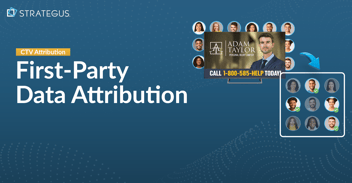
First-Party Attribution: Match Ads to Sales With CRM Data
The value of first-party data continues to grow.
7 minutes read

